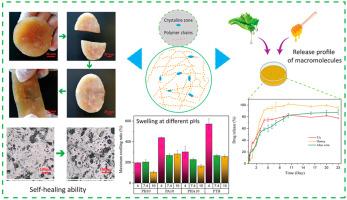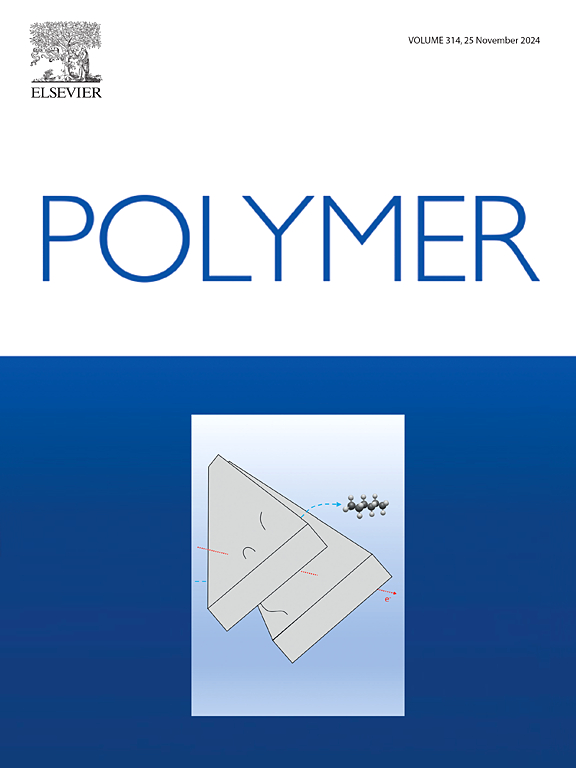Multifunctional stimuli-responsive self-healing polyvinyl alcohol/tannic acid/thyme-honey/aloe vera hydrogel as promising antibacterial drug delivery platforms: Physicochemical and in vitro biological assays
IF 4.5
2区 化学
Q2 POLYMER SCIENCE
引用次数: 0
Abstract
The utilization of hydrogels in biomedical applications has been on the rise due to their capability to create a moist wound environment and composite with a diverse range of organic and mineral compounds. Our objective was to prepare a pH-responsive system with self-healing and excellent antibacterial properties, capable of releasing active agents at the wound site. Polyvinyl alcohol/tannic acid/thyme-honey/aloe vera hydrogels were synthesized through a freeze-thaw method and characterized for structural, chemical, morphological, antibacterial, and cytotoxicity properties. The hydrogels exhibited remarkable mechanical properties, including tensile strength ranging from 2.51 to 331.44 kPa and compression strength from 2.55 to 16.54 kPa, with viscoelastic behavior suitable for various body tissues. They demonstrated an average healing efficiency of 81 % within 10 min, enduring mechanical stress commonly encountered in wound dressings. The study evaluated their swelling behavior and pH responsiveness, revealing their potential for maintaining a well-hydrated wound environment. The release profiles of tannic acid, thyme-honey, and aloe vera were 82 %, 100 %, and 88 % within 23 days, respectively. The hydrogels demonstrated outstanding antibacterial efficacy, with an average inhibition rate exceeding 98 % against both E. coli and S. aureus, and up to 99 % with thyme-honey and aloe vera, enhancing cell proliferation capacity. Overall, the samples are non-toxic, antibacterial, and cost-effective, making them suitable for wound healing and drug delivery.


多功能刺激反应自修复聚乙烯醇/单宁酸/百里香蜂蜜/芦荟水凝胶作为有前途的抗菌药物传递平台:理化和体外生物分析
水凝胶在生物医学应用中的应用一直在上升,因为它们能够创造湿润的伤口环境,并与多种有机和矿物化合物复合。我们的目标是制备一种具有自我修复和优异抗菌性能的ph响应系统,能够在伤口部位释放活性剂。采用冻融法合成了聚乙烯醇/单宁酸/百里香蜂蜜/芦荟水凝胶,并对其结构、化学、形态、抗菌和细胞毒性进行了表征。水凝胶具有良好的力学性能,抗拉强度在2.51 ~ 331.44 kPa之间,抗压强度在2.55 ~ 16.54 kPa之间,具有适合于各种人体组织的粘弹性行为。他们在10分钟内显示出81%的平均愈合效率,承受了伤口敷料中常见的机械应力。该研究评估了它们的肿胀行为和pH反应性,揭示了它们维持伤口水分充足环境的潜力。单宁酸、百里香蜂蜜和芦荟在23 d内的释放率分别为82%、100%和88%。该水凝胶对大肠杆菌和金黄色葡萄球菌的平均抑制率超过98%,对百里香蜂蜜和芦荟的平均抑制率高达99%,增强了细胞的增殖能力。总的来说,这些样品是无毒的,抗菌的,并且具有成本效益,使它们适合伤口愈合和药物输送。
本文章由计算机程序翻译,如有差异,请以英文原文为准。
求助全文
约1分钟内获得全文
求助全文
来源期刊

Polymer
化学-高分子科学
CiteScore
7.90
自引率
8.70%
发文量
959
审稿时长
32 days
期刊介绍:
Polymer is an interdisciplinary journal dedicated to publishing innovative and significant advances in Polymer Physics, Chemistry and Technology. We welcome submissions on polymer hybrids, nanocomposites, characterisation and self-assembly. Polymer also publishes work on the technological application of polymers in energy and optoelectronics.
The main scope is covered but not limited to the following core areas:
Polymer Materials
Nanocomposites and hybrid nanomaterials
Polymer blends, films, fibres, networks and porous materials
Physical Characterization
Characterisation, modelling and simulation* of molecular and materials properties in bulk, solution, and thin films
Polymer Engineering
Advanced multiscale processing methods
Polymer Synthesis, Modification and Self-assembly
Including designer polymer architectures, mechanisms and kinetics, and supramolecular polymerization
Technological Applications
Polymers for energy generation and storage
Polymer membranes for separation technology
Polymers for opto- and microelectronics.
 求助内容:
求助内容: 应助结果提醒方式:
应助结果提醒方式:


